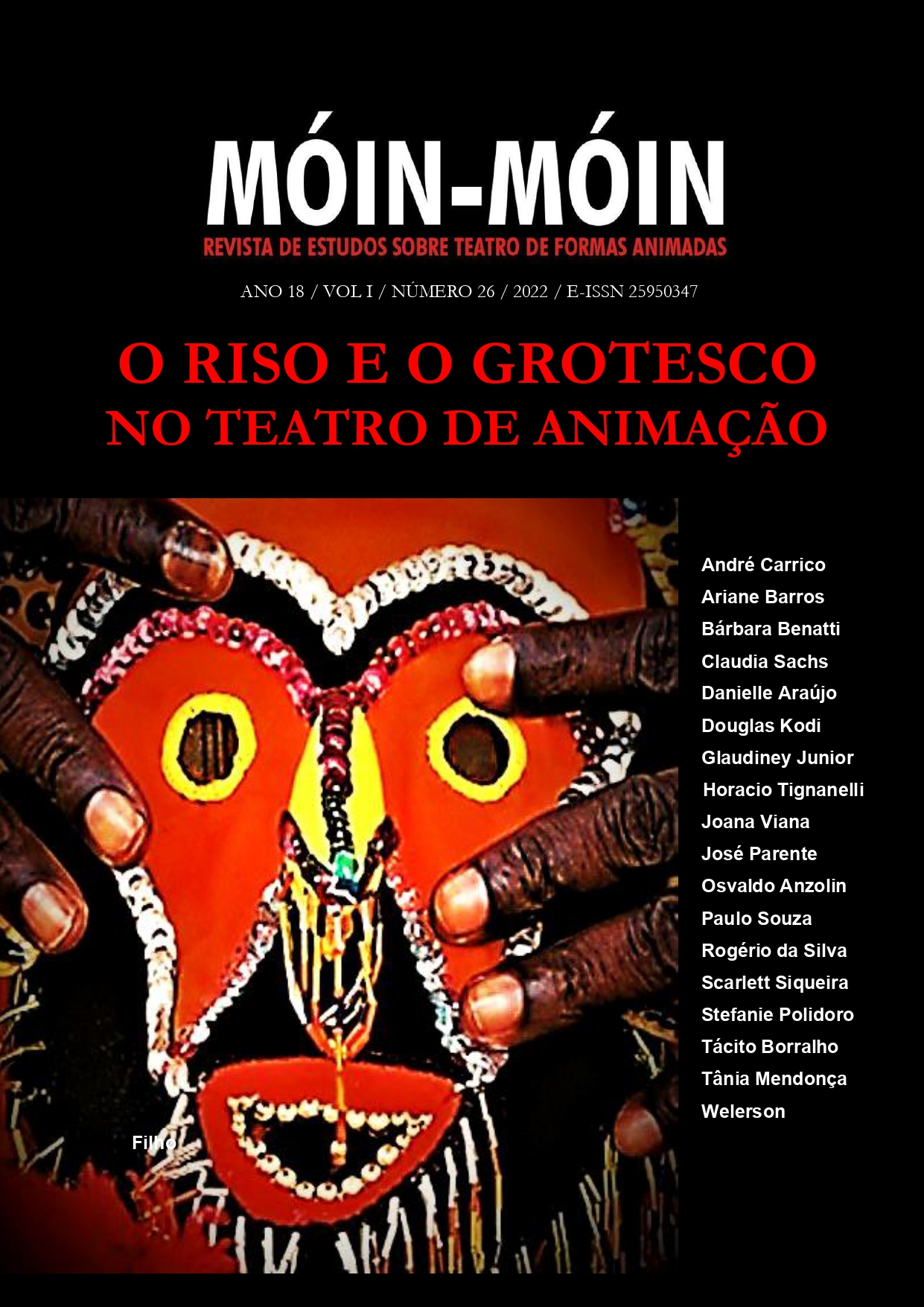O grotesco acontece por catástrofe? da experiência pessoal com Ternurinha ao Cabeção, de Maria Eugênia Tita
DOI:
https://doi.org/10.5965/2595034701262022136Parole chiave:
Maria Eugênia Tita, grotesco, riso, risívelAbstract
Este artigo inicia apresentando um percurso de investigação acerca do grotesco, enfatizado na relação entre a atriz e sua personagem bufonesca Ternurinha. A perspectiva adotada para abordar o tema do grotesco é elaborada a partir do diálogo com a linguista estadunidense Mary Russo, com os professores e pesquisadores da área de comunicação da UFRJ Muniz Sodré e Raquel Paiva, e com o psicanalista suíço Carl Jung. Com base nesse diálogo, é indagado se o grotesco é necessariamente risível, e sobre ele, discute-se a pergunta da pesquisadora, professora e palhaça Ana Fuchs: “Do que estamos rindo?”. A última parte do artigo é dedicada ao Cabeção, personagem criado pela bailarina, pesquisadora e brincante Maria Eugênia Tita, trazido para exemplificar e auxiliar a refletir sobre os estados grotescos que podem ser percebidos a partir dele.
Downloads
Riferimenti bibliografici
CABRAL, Muniz Sodré A.; SOARES, Raquel Paiva de A. O império do grotesco. Rio de Janeiro: Mauad, 2002.
FUCHS, Ana Carolina Müller. O Sorriso da Palhaça: pedagogias do riso e do risível. 2020. 295 f. Tese (doutorado) Universidade Federal do Rio Grande do Sul, Faculdade de Educação, Programa de Pós-Graduação em Educação: Porto Alegre, 2020. Disponível em: https://www.lume.ufrgs.br/handle/10183/218425. Acesso em: 6 mar. 2023.
JUNG, Carlos. G. A vida simbólica. Petrópolis: Vozes, 1998. V. XVIII.
LOTTA, Gabriela; OLIVEIRA, Vanessa Elias de; PIRES, Roberto. Burocracia e políticas públicas no Brasil: interseções analíticas. Brasília: Ipea: Enap, 2018.
PERES, Olivia; RICOLDI, Arlene. A quarta onda do feminismo? Reflexões sobre movimentos feministas contemporâneos. In: ANPOCS. Portal das Ciências Sociais Brasileiras. 42 Encontro Anual da ANPOCS. Disponível em: http://www.anpocs.com/index.php/encontros/papers/42-encontro-anual-da-anpocs/gt-31/gt08-27/11177-a-quarta-onda-do-feminismo-reflexoes-sobre-movimentos-feministas-contemporaneos?path=42-encontro-anual-da-anpocs/gt-31/gt08-27. Acesso em: 10 jul. 2022.
POLIDORO, Stefanie Liz. Eu-Ternurinha: o processo criativo e curativo da atriz-personagem a partir de seus excessos e vivências nas ruas, e o ativismo político e feminista que compõem suas teatropalestras. Tese (doutorado) - Universidade do Estado de Santa Catarina. Centro de Artes, Programa de Pós-Graduação em Teatro. Florianópolis, 2020.
RUSSO, Mary. O grotesco feminino: risco, excesso e modernidade. Trad. Talita M. Rodrigues. Rio de Janeiro: Rocco, 2000.
TITA, Maria Eugênia. Palestra Olhares aos brincantes: possibilidades cênicas e pedagógicas a partir do universo tradicional brasileiro. Proferida no dia 24 de junho de 2022, via Google Meet.
Downloads
Pubblicato
Come citare
Fascicolo
Sezione
Licenza
Copyright (c) 2022 Móin-Móin - Revista de Estudos sobre Teatro de Formas Animadas

TQuesto lavoro è fornito con la licenza Creative Commons Attribuzione 4.0 Internazionale.
Ao submeter um artigo à Móin-Móin Revista de Estudos Sobre Teatro de Formas Animadas e tê-lo aprovado os autores concordam em ceder, sem remuneração, os seguintes direitos à Revista: os direitos de primeira publicação e a permissão para que a Revista redistribua esse artigo e seus metadados aos serviços de indexação e referência que seus editores julguem apropriados.
Os artigos cujos autores são identificados representam a expressão do ponto de vista de seus autores e não a posição oficial da revista Móin-Móin.
Plágio, em todas as suas formas, constitui um comportamento antiético de publicação e é inaceitável. A Revista Móin-Móin reserva-se o direito de usar software ou outros métodos de detecção de plágio para analisar os trabalhos submetidos.
![]()
Este obra está licenciado com uma Licença Atribuição-NãoComercial 4.0 Internacional






